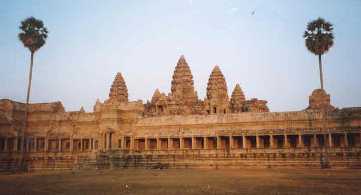
Cambodia

An introduction to the geography, economy and people of Cambodia.
Cambodia Facts
Cambodia has a tropical climate which is rainy, a monsoon season lasts from May to November and dry season from December to April. There is little seasonal temperature variation. It is surrounded by Laos, Vietnam, Thailand and the Gulf of Thailand. The capital city of Cambodia is Phnom Penh. Its land area is about 181,040 km² and its coastline is 443 km long. Monsoonal rains from June to November, flooding and occasional droughts are natural disasters experienced in Cambodia. Most of Cambodia's land (about 66%) is forested. The land is mostly low, flat plains with some mountains in southwest and north. Phnom (Mount) Aural in the west is the highest mountain, about 1800 m tall. The main natural resources in Cambodia are timber, gemstones, some iron ore, manganese, phosphates and hydropower potential. Illegal logging activities throughout the country and strip mining for gems in the western region along the border with Thailand have resulted in habitat loss and declining biodiversity and destruction of mangrove swamps, in particular, threatens natural fisheries. In rural areas, a majority of the population does not have access to potable water. And, toxic waste delivery from Taiwan sparked riots in Kampong Saom (Sihanoukville) in December 1998. A major city in Cambodia is Siemreab, in the north.
Cambodia became independent from France on the 9th of November 1953. Cambodia is a multiparty liberal democracy under a constitutional monarchy. King Norodom Sihanouk is the head of state and Prime Minister Hun Sen is the head of the government. A Council of Ministers is appointed by the monarch and deals with executive matters. The monarch is chosen by a Royal Throne Council and the prime minister is appointed by the monarch after a vote of confidence by the National Assembly. The legal system in Cambodia is primarily a civil law, a mixture of French-influenced codes from the United Nations Transitional Authority in Cambodia (UNTAC) period, royal decrees and acts of the legislature, with influences of customary law and some remnants of communist legal theory. There is an increasing influence of common law in recent years.
In the early 1990s, Cambodia's economy did very well, but due to the financial crisis of 1997, Cambodian economic growth slowed down tremendously. Foreign investment and tourism fell and the main harvest of 1998 was affected by drought. However, in 1999, progress was made on economic reforms and growth resumed at 4%. The long-term development of the economy after long periods of war is still a daunting task. The population lacks education and skills, particularly in the countryside which is poverty-ridden. Cambodia's rural areas suffer from an almost total lack of basic infrastructure. Political instability and corruption within the government discourage foreign investment and keep away foreign aid. Happily, the government is addressing these issues with assistance from bilateral and multilateral donors. As long as Cambodian political stability lasts, the economy is likely to grow at a moderate pace. Cambodia's currency is the new riel.
The population of Cambodia is about 12,210,000 and the population growth rate is about 2.2%. Life expectancy is around 57 years at birth. Cambodia is mostly Khmer (90%). Vietnamese (5%), Chinese (1%) and other races (4%) make up the remainder of the population (10%). Religions in Cambodia are Theravada Buddhism 95% and other 5%. Languages spoken are Khmer (official) 95%, French and English. The literacy rate is 35%.

Ideally, this website should be viewed using Internet Explorer 5.